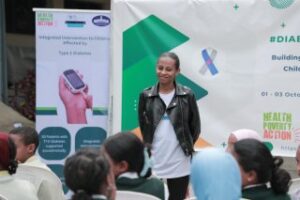
In low- and middle-income countries, a child’s Type 1 Diabetes diagnosis can put huge strain on families. The cost of daily care is too high for many to afford, and limited understanding in schools and communities can make children feel isolated and teachers unprepared to respond to their unique health challenges.
Our new programme in Ethiopia supports families affected by T1D to boost their income through small business initiatives and trains local health workers in diabetes management. Another aspect of the programme provides school-based education to reduce stigma and strengthen understanding among children and teachers.
We know that long-term health can improve social and economic outcomes for families and children and reduce the burden of this disease on their lives.
Building understanding in schools
One part of this project takes place in classrooms, where children, teachers and parents learn how to recognise diabetes symptoms, respond in emergencies and build empathy for classmates living with the condition.
Why is this so important?
Efison’s journey with type 1 diabetes: struggle, faith, and hope
 Efison, who shared her experiences at the event, was diagnosed with Type 1 Diabetes ten years ago. She remembers the confusion of her early symptoms and the struggle to understand how to manage her blood sugar.
Efison, who shared her experiences at the event, was diagnosed with Type 1 Diabetes ten years ago. She remembers the confusion of her early symptoms and the struggle to understand how to manage her blood sugar.
“My doctor’s advice was very clear; he told me to stop all carbohydrates and take insulin, but he didn’t explain what type of insulin I was using or why I needed it. This lack of information made it harder to manage my condition, causing my blood sugar to fluctuate between very high and very low.”
Even when she tried to follow medical advice, the ‘right foods’ were not always accessible or affordable.
Accepting her diagnosis was one of the hardest parts. “At first, I told myself that God would heal me,” she says. “That made it difficult to face reality.”
Over time, Efison learned to manage her condition and now helps others do the same.
“I lost two family members to diabetes,” she says. “That pushed me to help others find strength. I want people to know they can live well with this condition.”
Today, Efison raises awareness through social media and community gatherings, encouraging early diagnosis and understanding. Her hope is for children in Ethiopia to have access to the same technologies that make diabetes management easier elsewhere, so they can grow up without the daily burden of injections, misunderstandings and stigma.
Teachers creating safe classrooms
For many teachers, this training was transformative.
“We once had a student faint in class, and we didn’t know why,” said one physical education teacher. “Now I know how to recognise diabetes symptoms and respond the right way. I also plan to research exercises that are safe for children with diabetes so I can give better support.”
 Through HPA’s school-based sessions, teachers are learning practical steps such as how to recognise low and high blood sugar, when to give food, and when to seek medical help. They are also encouraging compassion and inclusion among students.
Through HPA’s school-based sessions, teachers are learning practical steps such as how to recognise low and high blood sugar, when to give food, and when to seek medical help. They are also encouraging compassion and inclusion among students.
“From what I’ve seen, students with diabetes often face challenges like self-isolation, low self-esteem, mood swings, or the belief that they are less capable than their peers. These feelings can stop them from fully participating in school life.”
Through these sessions, teachers are not only learning to respond to medical needs, but they are also helping change the culture of their schools, making them safer and more inclusive places for every child.
“We can teach all students that diabetes isn’t contagious, and that their classmates can do everything they can.”
Everyone has their part to play in creating empathy and awareness
Students, too, are putting what they have learned into action. One participant explained how the sessions changed her perspective:
“I used to think diabetes was just one disease. I didn’t know there were different types, or that missing the symptoms could be dangerous. Now I can help classmates if they’re not feeling well.”
She and her peers are now working together to raise awareness in their school, teaching others about Type 1 Diabetes, how to respond to emergencies, and how to make sure everyone feels safe and included.
“Children with diabetes are no different from us,” she says. “We should encourage and include them, not treat them differently.”
A lasting impact
By building understanding at every level, from families to schools, this project is helping children with type 1 diabetes live healthier, more confident lives. The knowledge shared in these sessions will continue to be passed on for years to come, shaping how future generations understand and respond to diabetes and those living with it.
This work is part of the T1DCommunityFund network, a global movement connecting community-based responses to type 1 diabetes across more than 30 countries.

